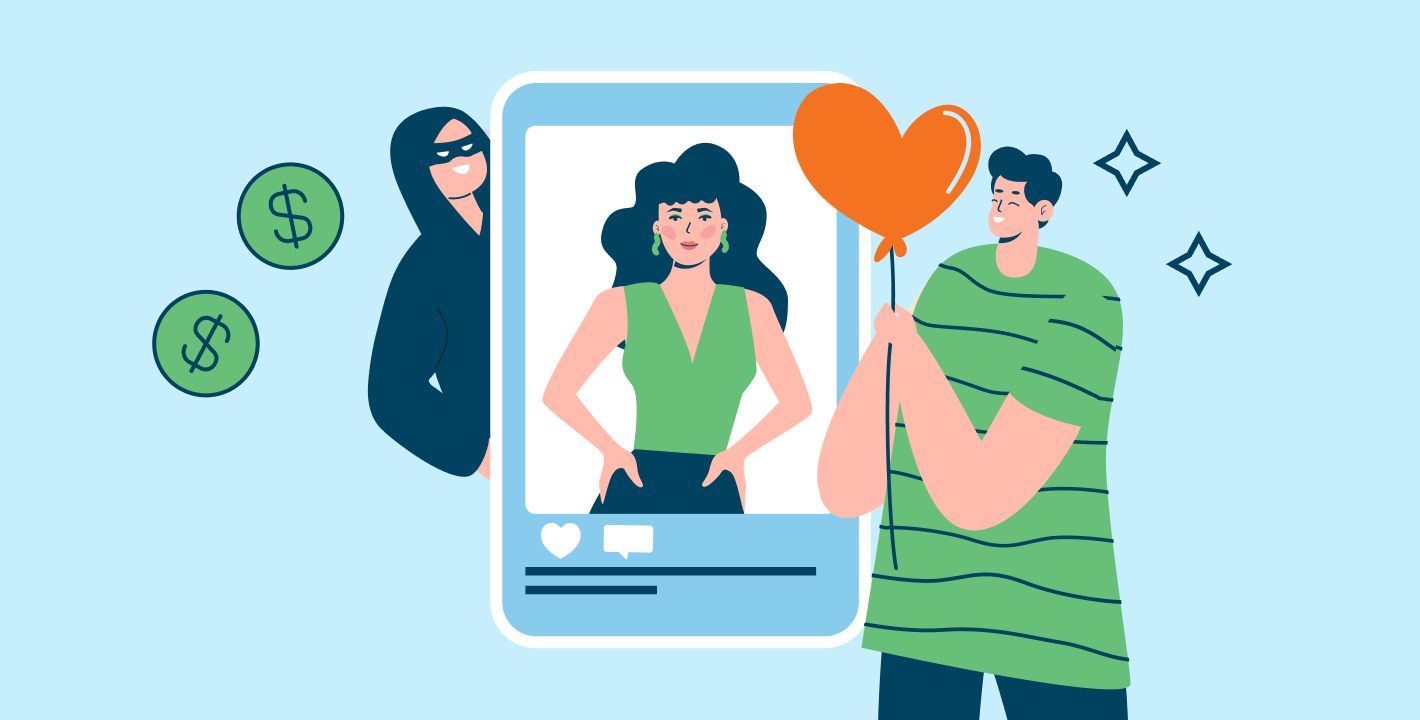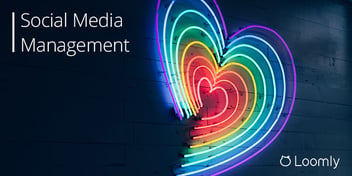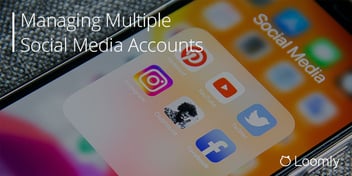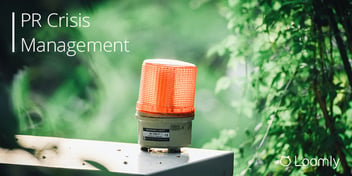As businesses and individuals build their social media presence, they’re inherently exposed to more risks. Simply put, the greater your reach across platforms, the greater your exposure to bad actors, security breaches, or damage to your brand.
It’s more important than ever to understand the risks of social media so you and your team can stay ahead of the curve, and mitigate any negative impact on you, your business, and your reputation.
In this guide, we’ll explore what social media risks are, who is most vulnerable to the dangers of social media, the most common social media risks, and how to protect yourself against them.
What are social media risks?
Social media risks are the potential dangers or threats that come as a result of using social media. These risks encompass a wide range of areas, including privacy, security, reputation, mental health, and societal well-being.
One key aspect of social media risks is the interconnectedness of multiple social media sites and users, which amplifies the potential consequences of such dangers. Information shared on one platform can quickly spread across networks, making it challenging to control and mitigate the risks associated with it.
The implications of social media risks are wide-ranging and can have profound effects on individuals and organizations. At the individual level, social media risks can compromise privacy, personal safety, and emotional well-being. Potential consequences include unauthorized access to personal information, cyberbullying, reputation damage, and negative effects on mental health.
For organizations, social media risks also pose significant challenges. Reputational damage caused by viral misinformation, security breaches, or negative customer experiences can result in financial losses and erode consumer trust. Legal repercussions may also arise from privacy violations or the sharing of inflammatory content.

Manage all your social media accounts in one place.
Craft, schedule, & auto-post content to all your social channels, then track analytics and manage interactions from a single, easy-to-use dashboard.
Security Risks
1. Unmonitored social media accounts
Social media accounts that are left unattended or are no longer used are a target for hackers. Once they gain control, they can post fraudulent content, misinformation about your brand, and virus-infected links or malware.
Mitigation: Monitor all your social media accounts regularly to ensure they haven’t been compromised. Loomly Interactions helps you manage comments, mentions, and messages on your social media accounts.
2. Imposter accounts
Imposter accounts are those accounts that look like they’re genuine but, under closer inspection, turn out to be fake accounts. They pose a significant risk on social media platforms, leading to various fraudulent activities and spreading misinformation. To combat this issue, social media platforms are actively taking measures. For instance, LinkedIn removed 58.1 million fake accounts in the fourth quarter of 2022.
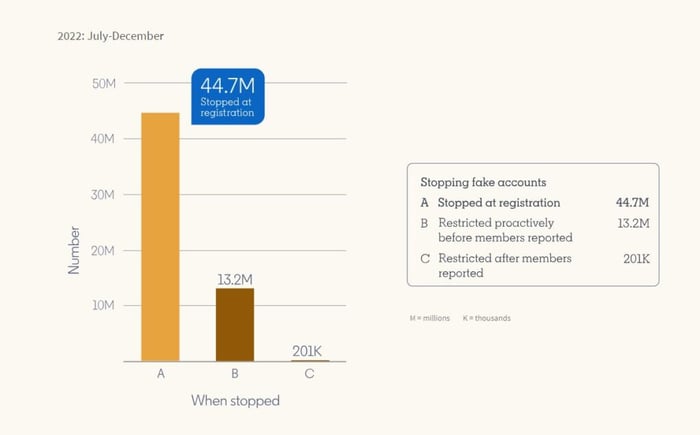
Facebook removed 1.3 billion fake accounts in Q4 2022 alone, demonstrating the widespread existence of deceptive profiles.
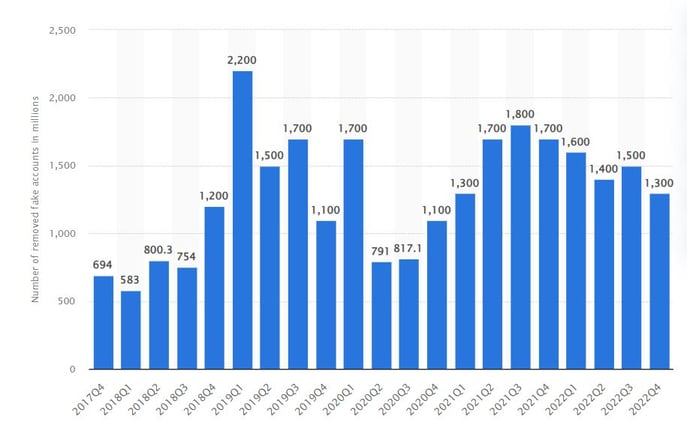
Mitigation: Get your social media accounts verified with the blue tick so people recognize your brand’s genuine account. This verification symbol indicates credibility and minimizes the chances of your followers falling prey to imposter accounts. Also, before engaging in influencer marketing, thoroughly vet potential influencer accounts. Such precautions help safeguard against fake accounts and foster a more secure social media environment.
3. Privacy settings
Privacy settings play a crucial role in safeguarding personal information and minimizing the risks associated with social media. However, many users, including brands, simply accept their social media account’s “default settings” when creating a new profile or page for their business.
Studies show that social media platforms and food delivery apps collect the most user data of all software, with an average of 20 user data points. Furthermore, a staggering 77% of all iOS apps track private user data, raising privacy concerns about the extent of data surveillance.
Mitigation: Make sure you have IT and User Policy Guidelines that outline what settings should be used when creating new social media accounts. These guidelines should provide instructions on how to enhance privacy, limit data collection, and protect sensitive information. By implementing these guidelines, individuals and businesses can take proactive measures to assuage their privacy concerns.
4. Vulnerable third-party apps
Even if you’ve secured your social media accounts, there may be back doors in third-party apps that hackers can expose.
Be selective when using third-party apps, especially those that require your login information.
Mitigation: Make sure you use certified and trusted third-party apps that are official partners of social media companies, such as Loomly.
5. Human error
We’re all human and prone to mistakes. Nowadays, we’re more careful with dodgy emails but not as smart with social media. It only takes one innocent click or download to expose a company to hackers, fraudsters, and scammers. (See below for types of attacks).
Also, people on your team could inadvertently post confidential or sensitive information.
Mitigation: Run training sessions to educate your staff on the dangers to look out for and what to do if they think they have made a mistake.
6. Phishing attacks and scams
A phishing scam (also known as vishing, smishing, or pharming) aims to get users to disclose login credentials for their work account, bank account, credit card, or other private information.
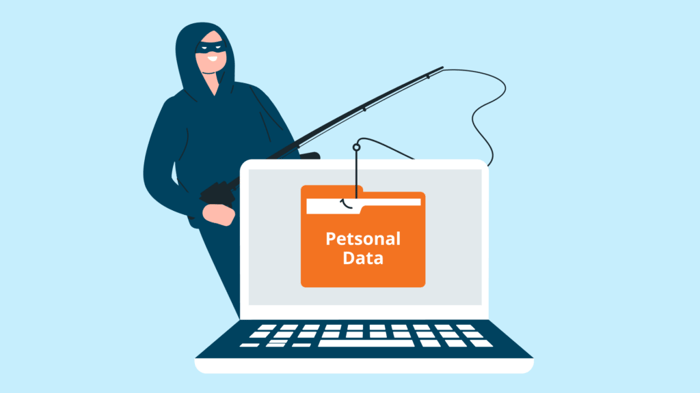
Mitigation: Conduct basic security awareness training for your team. Show them how to recognize phishing messages and caution them not to open and download files from unknown sources. Loomly Interactions also allows you to assign any comment, message, or @mention received on your social media account to your team as a way to consult with them before taking action.
7. Malware attacks and hacks
Malware attacks and hacks are one of the biggest security threats to brands on social media.
Attacks can be focused and targeted, where ‘cyber gangs’ go after organizations with advanced malware campaigns. For instance, one cyber gang built trust with oil and gas professionals on LinkedIn before sending them an Excel file containing malware that stole login credentials and other private information.
Hackers can also gain access to individual accounts and post harmful messages. For example, the Twitter account of NBA Giannis Antetokounmpo from the Milwaukee Bucks was hacked and used to post racial slurs and other profanities.
Mitigation: Conduct basic security awareness training for your team. Show them how to recognize malware attacks. Don’t open or download files from unknown sources. Use endpoint security software to protect your data.
8. Unsecured mobile phones
Many users have social media apps on their mobile phones. If it gets stolen, then thieves have access to social media accounts where they can post damaging content, plus send phishing and malware scams to your connections.
Mitigation: Protect mobile phones with a password, fingerprint, or face recognition lock to reduce the risks.
Consider using social media policy guidelines (in conjunction with IT) on how to:
- Create a secure password and how often to change it
- Keep software and devices updated
- Identify and avoid spam, phishing attacks, and other security threats
- Report social media security concerns
- Avoid social networks’ default privacy and security settings
- Avoid social media activities that ask for personal information
- Share on-brand and approved content
- Adhere to copyright and confidentiality rules
- Engage appropriately on behalf of the brand
Legal Risks
9. Legal and HR issues
It’s surprisingly easy for brands to publish unauthorized content that breaches the law. Potential issues include privacy laws, content ownership, and intellectual property (IP) infringement. Plus, there are potential HR issues such as harassment, discrimination, and defamation.
Mitigation: Make sure your legal and HR teams approve content in your social media workflow before it’s published. Loomly was designed to streamline collaboration, allowing you to preview and approve posts before they go live.
10. Data privacy and protection
Collecting, processing, handling, and storing data is a hot topic, especially as the rules and regulations for each country are different. Global brands need to comply with local data protection regulations when they post social media content and also share assets across borders.
Mitigation: Make sure your brand complies with location-specific data privacy and protection laws. Consult with local legal experts where necessary.
11. Compliance
With more than 10,000 rules and regulations governing electronic communications in the US alone, brands have to comply (and provide proof of compliance) with industry regulations, especially in the finance and healthcare sectors.
Mitigation: Follow and adhere to industry regulations. Get legal and compliance teams to review and approve content before it’s published. This is another area where Loomly can come in handy, thanks to a signature team approval workflow.
Financial Risks and Costs
12. Financial
Any mistake on social media can have a negative impact on finances, including:
- Fines from industry regulators
- Penalties from data protection enforcement agencies
- Decreases in share price
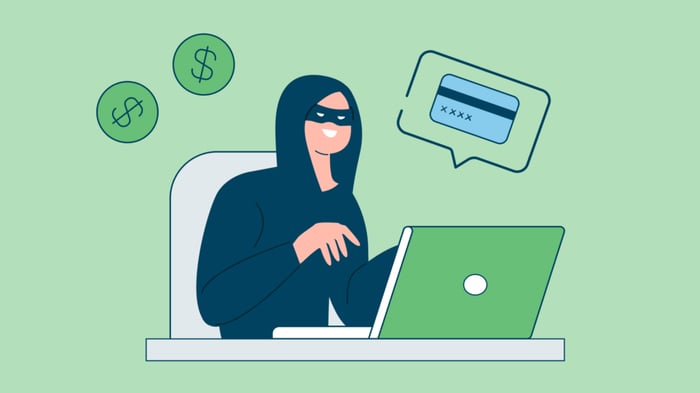
Mitigation: Enforce social media governance to prevent mishaps and financial penalties.
13. Costs
Although it’s free to create social media accounts, there are associated costs, including:
- Social media advertising costs
- Social media management tools
- Social media employees, including a social media manager
- Social media agencies, if you choose to outsource activities
- Freelance writers and designers to develop content
- Legal experts to work through governance issues
Mitigation: Establish and manage a social media marketing budget to avoid costs spiraling out of control.
Operational Risks
14. Processes
Without the right operational processes in place, there’s a risk that the wrong people will get access to social media accounts or the wrong content will get published at the wrong time.
Mitigation: Define and approve the right access, permissions, approvals, and collaboration processes before you start publishing social media content. This is precisely what Custom Roles were designed for in Loomly.
15. Bandwidth
Firms need the right amount of resources to develop, manage, and supervise social media programs. As well as creating and publishing content, social media workflow approvals require professionals from the appropriate departments in the company, such as:
- Sales: to check the correctness of any sales messages
- Product: to check the accuracy of product information
- HR: to ensure the updates are in line with company policy
- Finance: to ensure there are no budget issues
- Legal: to ensure there are no liability issues
- Third parties: any clients, agencies, or contractors you may be working with
Mitigation: Make sure you have the bandwidth in resources across your company to properly manage social media marketing. Streamlining your collaboration process is a great first step if your team is spreading thin: check out Loomly to accomplish that.
16. Productivity
There’s been ample research on the negative impact of excessive social media access, with employee productivity levels dropping by as much as 9.5%. This poses a significant risk to both employees and the organization’s business operations.
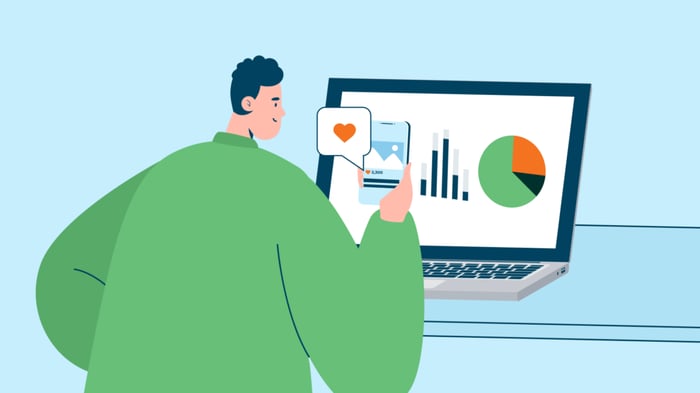
Mitigation: Monitor and regulate how much time employees spend on social media. By tracking usage, organizations can identify patterns of excessive or inappropriate behavior and address the issue promptly. If necessary, the matter can be raised with HR to ensure proper intervention and guidance. Additionally, implementing a comprehensive social media policy for your business can provide clear guidelines on acceptable and unacceptable usage of social media during work hours.
Brand Reputation Risks
17. Reputation
As social media content is published on platforms outside of an organization, there’s an immediate risk that a brand’s reputation can be damaged. Whether it’s a human error, an oversight, or a security hack, it can have a negative impact on the brand and lead to a loss in the confidence of customers and investors.
Mitigation: Put strict training and guidelines in place so everyone knows the security risks of social media. Also, social media workflows need to be as robust as possible to prevent any mishaps.
Content Strategy Risks
18. ROI
Executives expect a return on investment from social media marketing.
Mitigation: Define your social media goals and metrics so they align with business goals. For example:
- Business goal: increase customers
- Marketing goal: increase leads and conversions
- Social media goal: increase followers and engagement
Measure your social media performance and adjust the strategy accordingly to meet your goals. Loomly Advanced Analytics empowers you to measure your success in a clean dashboard.
19. Inconsistency
Brands often publish content on social media without any research or plan of action. Posts get published in an ad-hoc manner, which could result in over-publishing or under-publishing, plus the tone, voice, and style of content may be inconsistent.
Mitigation: Use a social media calendar, also called an editorial calendar, to help you plan and publish high-quality social media content consistently. It’ll help you:
- Plan your content ahead of time
- Create a regular publishing schedule
- Tell a consistent and compelling brand story over time
Loomly Tip: You can build a social media calendar using a free online template or a professional, dedicated tool, such as Loomly.
20. Negative feedback
Social media apps allow you to interact directly with your audience in real time. And it also gives those same people a public forum to voice dissatisfaction, which can be damaging to your brand.
Mitigation: Use social listening tools to monitor the social media platforms you operate on so you can quickly identify negative feedback and address it before it gains unwanted traction.
21. User-generated content
User-generated content (UGC) can be dangerous if you make it too complex. Inviting users to share content with a campaign hashtag is usually fine. But brands that use auto-generated content can have problems.
For example, the National Lottery found that people sabotaged their World Athletics Championships hashtag campaign by using disparaging profile names.
Mitigation: Make sure you stay in control of any UGC campaigns to avoid issues. Loomly Interactions is a great place to start.
22. Organic-only content
While organic social media posts have their value, relying solely on organic content may limit your ability to achieve your goals and objectives. The reach and impact of organic-only content can be restricted, as it largely depends on algorithms and user engagement.
In contrast, paid content, such as Facebook ads, offers immense potential to expand your reach. With the ability to reach 33.3% of the global population, paid advertising provides a powerful tool to connect with a wider audience and achieve desired outcomes.
Mitigation: By using a blend of organic posts and targeted advertisements, you can optimize your reach, engagement, and overall social media success. Platforms like Loomly offer integrated solutions that empower you to create organic posts while also facilitating the creation of impactful Facebook and Instagram Ads, enabling consistent social media growth.
23. Getting left behind
Social media is a super-dynamic medium that’s always changing. With new platforms emerging, algorithms evolving, and audience preferences shifting, it’s crucial to stay proactive and informed.
One significant danger is the potential loss of social media engagement due to random algorithm changes. These changes can impact the visibility and reach of your content, leaving you behind your competitors and hindering your overall social media success.
Mitigation: Make sure you stay abreast of industry trends and monitor the news and behavior on social media sites, so you can stay ahead of the curve. The Loomly Blog & Newsletter are great places to keep up with best practices.
Who is most vulnerable to the dangers of social media?
While social media risks can affect individuals across various demographics, certain groups are considered more vulnerable due to specific factors. The following groups are often identified as being particularly susceptible to social media risks.
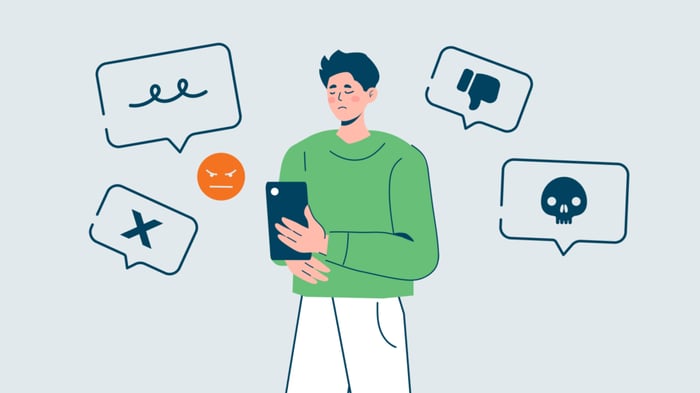
1) Children and teenagers
Children and teenagers are easily influenced and can be preyed upon by anonymous predators online. They may lack the critical thinking skills and emotional maturity to navigate the complexities of social media, making them more susceptible to cyberbullying, online grooming, and exposure to inappropriate messages.
2) Seniors
The elderly are especially susceptible to scams, as they may be unfamiliar with online safety practices. They may be targeted by identity thieves who exploit their trust or lack of digital literacy, leading to financial losses and compromised personal information.
3) People with limited digital literacy
Anyone with limited digital literacy has a higher vulnerability to scams and online threats. Without the necessary knowledge and skills to identify and address potential risks, they may unknowingly share sensitive information, fall for phishing attempts, or become victims of identity theft.
4) Individuals with mental health issues
People struggling with mental health issues such as depression or anxiety may be more negatively impacted by social media. They may encounter cyberbullying, experience feelings of inadequacy and social comparison, or be exposed to triggering content, exacerbating their mental health challenges.
5) Public figures
Public figures such as celebrities often have to deal with targeted harassment, reputational damage, and misinformation about their brand. Their visibility and influence can make them prime targets for online attacks, stalking, and invasion of privacy.
6) Those seeking validation or approval
People who heavily rely on social media for validation or approval may be more susceptible to online manipulation, exploitation, and engaging in risky behaviors to gain social recognition. The constant need for external validation can lead to a lack of personal boundaries and a vulnerability to various forms of online exploitation.
Social media risks: wrapping up
Social media has become an indispensable part of the modern world, giving access to a wide range of opportunities. However, several of the factors that make social media so great, such as anonymity, speed of information, and accessibility, can also cause significant risks if not properly managed.
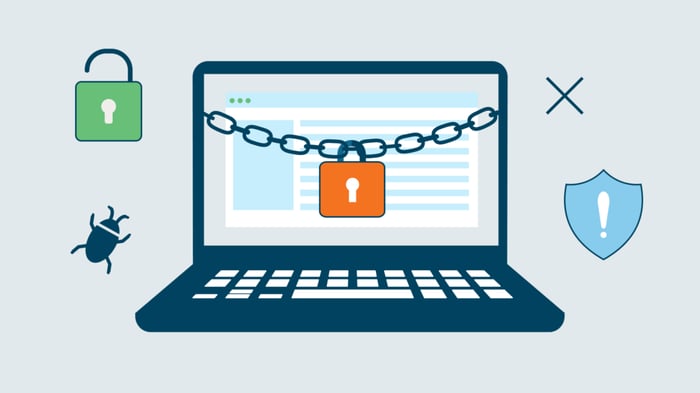
By understanding these risks, you can take proactive steps to mitigate them and foster a safer and more responsible digital environment. Taking the necessary steps to plan and protect your brand against the legal, financial, and operational risks of social media is the best way to future-proof your business.
Logging in and out of different social media sites increases the risk of your password getting stolen. For a single, easy-to-use, and secure social media management platform, choose Loomly. Start your 15-day free trial today.
